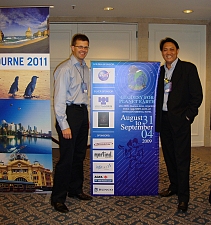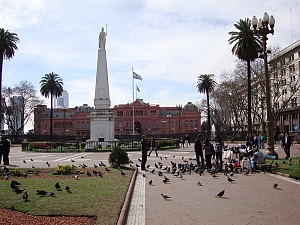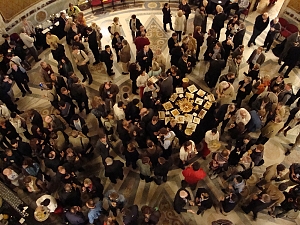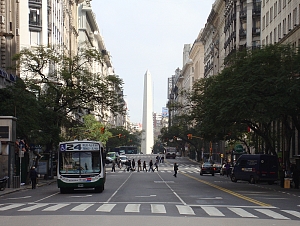FIG attends IAG 2009 ”Geodesy for Planet Earth”
Buenos Aires, Argentina, 31 August – 4 September 2009
|

Mikael Lilje (left) and Rob Sarib at the IAG 2009
conference in Buenos Aires. |

Buenos Aires in August 2009.
|
The International Association of Geodesy (IAG) organised the “Geodesy
for Planet Earth” conference in Buenos Aires, Argentina at the end of
August. FIG was invited and represented by Mikael Lilje, Chair Elect
of Commission 5 (Sweden) and Rob Sarib, Vice Chair of Administration
(Australia).
This scientific symposium is a biannual IAG event and attracted
approximately 500 delegates from 65 different countries. The event was held
at the Intercontinental Buenos Aires in the historic neighbourhood of
Monserrat. There were 500 technical / scientific papers submitted and 280 of
them were delivered as oral presentations. The technical program was run in
two parallel sessions with numerous business meetings held in the evenings
outside the ordinary technical program. There was also a poster program
prepared for this event and it was open to delegates for two days.
The conference technical program was focussed on IAG Commissions, key
projects and geodetic issues in the South Americas. Consequently the
sessions covered the following themes:
- Gravity
- Reference Frames
- Positioning and Applications (Co-sponsored by FIG, ION and ISPRS)
- Geodynamics
- Positioning and Remote Sensing
- GGOS
- IAG Services
- Geodesy in Latin America
There were two social events: Ice Breaker Reception at the exclusive
“Circulo Militar" and Gala Dinner at the “Madero Tango” in the modern area
of Puerto Madero.
FIG and IAG signed in 2001 a Memorandum of Understanding, which
recognised each organisation and the potential benefits of working together.
Since this signing a number of joint efforts have been made. This has
primarily consisted of IAG being very active at FIG events by giving
technical presentations, leading panel discussions and chairing sessions.
The IAG President and Vice-President as well as other prominent IAG
officials have regularly participated at FIG events. Even though FIG is
generally perceived by IAG delegates as a wealthy organisation comprising of
large network of operational surveyors there is a genuine and strong
interest in further collaboration.
Mikael Lilje and Rob Sarib were invited to participate at several IAG
Commission and Executive meetings and held numerous formal / informal
discussions.
A presentation on previous and future FIG and IAG liaisons was delivered
to the IAG Executive Committee (EC). The outcomes of this discussion were to
update the existing “liaison document” that is based on the MoU. Professor
Chris Rizos, incoming President of IAG, will take the lead on this
document and will use input from FIG representatives as well as from the
discussion within the IAG EC. It was clear that IAG would like to see more
co-operations with FIG and for the Commissions of IAG and FIG to identify
some specific projects that will produce tangible outcomes.
IAG Commission 1 (Reference Frames) work plan is to promote the
International Reference Frames, especially the ITRF-solutions globally and
regionally. An invitation for FIG Commission 5 to be involved in this IAG
working group was extended by the Chair Zuheir Altamimi. From an FIG
‘capacity building’ perspective the most interesting aspect was the
discussion of a “School on Reference Frames” which was to be held in mid
2010.
During the conference week, there were numerous discussions concerning
terrestrial ties or connections between various geodetic instruments (ie
VLBI, SLR, GNSS CORS etc) at ‘fundamental’ observation stations. FIG also
needs to note that IAG Commission 1 are organising a Reference Frame
symposium in Paris, October 2010, and FIG should encourage its National
Member organisation to attend and contribute.
IAG Inter Commission Project (1.2 IAG Vertical Reference Frame) is lead
by Johannes Ihde from Germany. Mr Ihde has also been involved in the
FIG Publication No 37 (FIG Guide on the Development of Vertical Reference
Surface for Hydrography).
IAG Commission 2 (Gravity) frequently organises the “School on Geoid
Determination” and this year it was held in Argentina directly after the IAG
Conference. FIG Commission 5 and IAG representative, Georgia Fotopoulos,
was one of the lecturers teaching at this school. It appears that this
school concept is a good example of how to organise education on a specific
subject especially in areas where there is a need for assistance.
Consequently, it is recommended FIG should seriously consider developing
similar initiatives by itself or in collaboration with others, such as IAG
or ION.
At the IAG Commission 4 (Positioning and Applications) meeting the joint
seminars organised by FIG, ION, IAG and ISPRS was discussed. Examples of
these are the Mobile Mapping, Deformation Measurement, and the 3D-Optical
Instrument symposia series. It was agreed at the meeting that these symposia
series should continued and be supported. In addition, a ‘specific’ project
was identified by FIG and this IAG Commission and this involved developing a
“Special Issue” in the publication of “Journal of Applied Geodesy”. The
special topic discussed involved ‘new positioning techniques and
infrastructure”.
The Global Geodetic Observing System (GGOS) is being promoted as the
‘flagship’ of IAG and that it will have an even greater impact in the future
of geodesy. According to Mike Sideris (IAG President):
- "GGOS is still evolving, but it is operational”
- The future operations of GGOS are through IAG Services and
Commissions.
- IAG Services provide the infrastructure and products to the
Geoscience community.
- IAG Commissions provide the expertise and support
- GGOS will assist to address ‘Global Change’ - especially in the
study areas of disaster management, global heating and climate change as
they are dependent on GGOS.
GGOS has also published a book called “GGOS 2010” which articulates the
above and gives the current status of geodesy and visions for the
contribution of GGOS to the community.
From an FIG perspective it is recommended that FIG should note the
efforts as well as encourage and facilitate this work. A possible way to do
so is to have dedicated sessions at FIG events, especially at the FIG World
Congress 2010, Sydney. It also should be noted that GGOS has an impact on
all FIG Commissions.
As a general comment it should be mentioned that an IAG event is a
scientific and technical symposium. Most of the presenters need to publish
their findings in a peer-reviewed publication. To access these papers the
general delegate will need to pay a fee and each scientific or technical
paper will not be available till sometime after each event. Also, at this
event it was clear that most of the invited presenters were asked to give
overview or status papers and / or state-of-the-art papers. The quality of
presentations varied of course as per most conferences, however the overall
quality of the presentations was of a high standard.
The technical /scientific papers and issues that were of relevance to FIG
Commission 5 were topics relating to:
- The new global reference frame ITRF 2008, which is not yet available
but expected in a few months.
- The maintenance and the management of geodetic infrastructure are
vital and will become even more vital as time progresses.
- Time series and discontinuities in time series and how to manage
them were issues that were discussed lively amongst the delegates
throughout the week.
- The Regional Reference Frames EUREF, AFREF, APREF, SIRGAS and so on
are moving forward but at their own pace due to regional issues (ie
politics, resources, capability)
- GGOS vision requires 40 Super sites globally but at the moment only
2 exists. There is a major need to gather support to build more sites /
observatories
- Precise Point Position was discussed and it was apparent that the
technique is getting more and more possible for real-time applications,
but the accuracy is still much lower than for network-RTK.
- It will take about one year for all the Conference proceedings to be
available but all papers will have gone through a peer review process.
No paper is published in the proceeding without being reviewed.
More to read:
Mikael Lilje
Chair-Elect FIG Commission 5
Rob Sarib
Vice- Chair Admin Commission 5
28 September 2009
|


























